|
Sunday:
October 28, 2001 | |
0104 GMT |
 |
Orbiting satellites map the Britain 'bounce'
Britain really does have its ups and downs. Parts of Cornwall, for example, rise and fall by about 10 cm every day. Now, scientists are using satellite technology to produce the first accurate map of Britain's 'bounce' to help civil engineers make ends meet when they build bridges, dams and tunnels.
 FULL STORY FULL STORY
 |  |
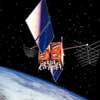
|
 |
|
Saturday:
October 27, 2001 | |
0149 GMT |
 |
JSC to develop technologies for future space flight
Sharpening its focus on the next generation of human space flight, a new office at the Johnson Space Center will develop technologies to lead to the next reusable human spacecraft, work that could mean hundreds of millions of dollars of research efforts managed from Houston over the next few years.
 FULL STORY FULL STORY
 |  |

|
 |
Alpha astronauts visit their launch and landing site
Back on Earth after their five months living aboard the International Space Station, Expedition Two astronauts Susan Helms and Jim Voss recently visited the Kennedy Space Center where they planted a commemorative cherry laurel tree. Here is a photo report of the astronauts' KSC visit.
 FULL STORY FULL STORY
 |  |

|
 |
Station experiment vibration dampener readied
An experimental "powered shock absorber" to reduce vibrations aboard the International Space Station continued another week of intensive testing to get ready for its operational debut next year.
 FULL STORY FULL STORY
 |  |
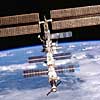
|
 |
|
Friday:
October 26, 2001 | |
0148 GMT |
 |
Leaky engine seals delay weather satellite launch
Originally planned to be the first U.S. launch of 2001, technical gremlins have kept an Air Force Titan 2 rocket and its military weather satellite grounded all year and the latest glitch could very well delay blastoff until late December.
 FULL STORY FULL STORY
 |  |

|
 |
ISO finds 30 'failed stars' in nearby stellar nursery
The impressive cloud in the region of the star rho Ophiuchi is one of the heavenly meeting points for astronomers in search of young stars. Located 540 light-years away, the dusty clouds are the nest of more than one hundred newborn stars. But ESA's Infrared Space Observatory has also found a surprise hidden in the dust.
 FULL STORY FULL STORY
 |  |

|
 |
DAILY BRIEFING Other stories making news today
|
 |
Eutelsat puts Atlantic Bird 2 into commercial service -- Eutelsat says its new satellite, Atlantic Bird 2, was brought into full commercial service last week. The spacecraft is significantly reinforcing Eutelsat capacity for satellite newsgathering, TV broadcasting and secure corporate networks in North and South America, Europe, the Middle East and Central Asia.
|
 |
|
Thursday:
October 25, 2001 | |
1545 GMT |
 |
"Mars, we're back"
In a press conference Wednesday, Mars Odyssey officials reported that the spacecraft has entered an accurate 18.5-hour orbit around the Red Planet following Tuesday night's successful 20-minute, 19-second engine firing. The craft arrived at Mars on a bulls-eye course, within one kilometer of the target.
 MISSION STATUS CENTER - updates MISSION STATUS CENTER - updates
 |  |

|
 |

Video coverage for subscribers only:

 AUDIO: REPORT ON ODYSSEY'S TRAJECTORY AND ORBIT QT or RV AUDIO: REPORT ON ODYSSEY'S TRAJECTORY AND ORBIT QT or RV
 AUDIO: SPACECRAFT SYSTEMS WORKED PROPERLY QT or RV AUDIO: SPACECRAFT SYSTEMS WORKED PROPERLY QT or RV
 VIDEO: PREVIEW OF AEROBRAKING MANEUVERS QT or RV VIDEO: PREVIEW OF AEROBRAKING MANEUVERS QT or RV
 AUDIO: OVERVIEW OF MARS ODYSSEY SCIENCE MISSION QT or RV AUDIO: OVERVIEW OF MARS ODYSSEY SCIENCE MISSION QT or RV
 VIDEO: ANIMATION OF ODYSSEY'S TREK TO MARS QT or RV VIDEO: ANIMATION OF ODYSSEY'S TREK TO MARS QT or RV
 VIDEO: ANIMATION OF ORBIT INSERTION BURN QT or RV VIDEO: ANIMATION OF ORBIT INSERTION BURN QT or RV
 MORE: COMPLETE SFN+ VIDEO INDEX MORE: COMPLETE SFN+ VIDEO INDEX

|
Shuttle moved from hangar for November launch
While the Expedition Three astronauts aboard the orbiting international space station were entertaining house guests on Wednesday, technicians at Kennedy Space Center moved shuttle Endeavour a step closer to launching a replacement resident crew next month.
 FULL STORY FULL STORY
 |  |

|
 |
SOHO sees solar eruptions and comet collision
A very bright Sun-grazing comet was discovered by the SOHO spacecraft while a pair of coronal mass ejections were heading for Earth, following two solar explosions this week.
 FULL STORY FULL STORY
 |  |

|
 |
DAILY BRIEFING Other stories making news today
|
 |
Molniya rocket lifts off -- A Molniya-M rocket was launched from Plesetsk Cosmodrome in Russia today carrying a classified military communications satellite.
|
 |
|
Wednesday:
October 24, 2001 | |
0612 GMT |
 |
Odyssey enters orbit
NASA's 2001 Mars Odyssey spacecraft successfully slipped into orbit around the Red Planet on Tuesday evening, capping its six-month, 285-million mile trek from Earth. It's the first probe to reach Mars safely after NASA lost two craft in 1999.
 MISSION STATUS CENTER - updates MISSION STATUS CENTER - updates
 THE ODYSSEY SPACECRAFT THE ODYSSEY SPACECRAFT
 |  |

|
 |

Video coverage for subscribers only:

 VIDEO: CONFIRMATION THAT ENGINE FIRING UNDERWAY QT or RV VIDEO: CONFIRMATION THAT ENGINE FIRING UNDERWAY QT or RV
 VIDEO: CELEBRATION AFTER ODYSSEY ENTERS ORBIT QT or RV VIDEO: CELEBRATION AFTER ODYSSEY ENTERS ORBIT QT or RV
 AUDIO: GOLDIN SAYS SUCCESS LIFTS AMERICAN SPIRIT QT or RV AUDIO: GOLDIN SAYS SUCCESS LIFTS AMERICAN SPIRIT QT or RV
 AUDIO: LANDANO SAYS ODYSSEY IN SUCCESSFUL ORBIT QT or RV AUDIO: LANDANO SAYS ODYSSEY IN SUCCESSFUL ORBIT QT or RV
 AUDIO: GOLDIN TALKS ABOUT ACCEPTABLE FAILURES QT or RV AUDIO: GOLDIN TALKS ABOUT ACCEPTABLE FAILURES QT or RV
 MORE: COMPLETE SFN+ VIDEO INDEX MORE: COMPLETE SFN+ VIDEO INDEX

|
Replacement Soyuz capsule docks to space station
A fresh Soyuz lifeboat capsule has been delivered to the international space station Tuesday with a docking at 6:44 a.m. EDT (1044 GMT). Two Russian cosmonauts and a French researcher aboard the Soyuz will spend a week at the outpost before riding the old Alpha capsule back to Earth.
 MISSION STATUS CENTER - updates MISSION STATUS CENTER - updates
 |  |
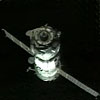
|
 |

Video coverage for subscribers only:

 VIDEO: DOCKING AS SEEN BY SOYUZ CAMERA QT or RV VIDEO: DOCKING AS SEEN BY SOYUZ CAMERA QT or RV
 VIDEO: INCREDIBLE STATION VIEW OF SOYUZ DOCKING QT or RV VIDEO: INCREDIBLE STATION VIEW OF SOYUZ DOCKING QT or RV
 MORE: COMPLETE SFN+ VIDEO INDEX MORE: COMPLETE SFN+ VIDEO INDEX

|
Astronomers find probable pulsar in supernova
NASA's Chandra X-ray Observatory has captured a spectacular image of a young, oxygen-rich supernova remnant with a pulsar at its center surrounded by outflowing material. Astronomers know that pulsars are formed in supernova explosions, but they are currently unable to identify what types of massive stars must die in order for a pulsar to be born.
 FULL STORY FULL STORY
 |  |

|
 |
|
Tuesday:
October 23, 2001 | |
0053 GMT |
 |
Odyssey probe poised to enter Martian orbit
NASA's 2001 Mars Odyssey spacecraft completes its six-month, 285-million mile cruise to the Red Planet on Tuesday evening with a make-or-break 20-minute engine firing to slip into orbit around Mars.
 MISSION STATUS CENTER MISSION STATUS CENTER
 |  |
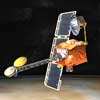
|
 |
Replacement Soyuz capsule set for Alpha docking
Two Russian cosmonauts and a French researcher are due to arrive aboard the international space station Tuesday. The crew is riding a fresh Soyuz capsule to the outpost. Docking is expected at 6:41 a.m. EDT (1041 GMT).
 MISSION STATUS CENTER MISSION STATUS CENTER
 |  |

|
 |
New energy source 'wrings' power from black hole spin
Scientists for the first time have seen energy being extracted from a black hole. Like an electric dynamo, this black hole spins and pumps energy out through cable-like magnetic field lines into the chaotic gas whipping around it, making the gas -- already infernally hot from the sheer force of crushing gravity -- even hotter.
 FULL STORY FULL STORY
 |  |

|
 |
India launches satellite trio aboard one PSLV rocket
India's Polar Satellite Launch Vehicle bolted from its launch pad Monday, successfully hauling three technology demonstration payloads into space. The PSLV rocket launched from India's Sriharikota complex, located on the east coast of the nation near the Bay of Bengal.
 FULL STORY FULL STORY
 |  |
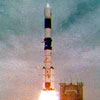
|
 |
DAILY BRIEFING Other stories making news today
|
 |
NASA picks proposals in advanced human support technologies -- NASA has selected 10 researchers to receive grants to develop advanced technologies needed to produce food, recycle water and air, and monitor spacecraft environments required for long-term human
space exploration.
|
 |
|
Monday:
October 22, 2001 | |
0200 GMT |
 |
Station lifeboat launches
A Russian Soyuz spacecraft blasted off at 0859 GMT (4:59 a.m. EDT) Sunday from the Baikonur Cosmodrome in Central Asia, bound for the international space station. The Soyuz TM-33 capsule will become the new escape vehicle for Alpha's resident crew, replacing the existing craft that is reaching the end of its certified lifespan.
 MISSION STATUS CENTER MISSION STATUS CENTER
 |  |

|
 |
Station science update
A Glenn Research Center Experiment on Physics of Colloids in Space is continuing a week of daily tests aboard the International Space Station, commanded by the science team on the ground.
 FULL STORY FULL STORY
 |  |

|
 |
Craft uses new technology with many potentials
Big things come in tiny packages ... 40,000 tiny packages of gamma ray detectors to be exact. The 40,000 thumbtack-sized detectors were recently delivered to the scientists building NASA's Swift Gamma-Ray Burst Explorer. The detectors may allow advances in medical and security imaging, also.
 FULL STORY FULL STORY
 |  |

|
 |


 The Hubble Space Telescope's majestic view of the Eskimo Nebula. This spectacular poster is available now from the Astronomy Now Store.
The Hubble Space Telescope's majestic view of the Eskimo Nebula. This spectacular poster is available now from the Astronomy Now Store.